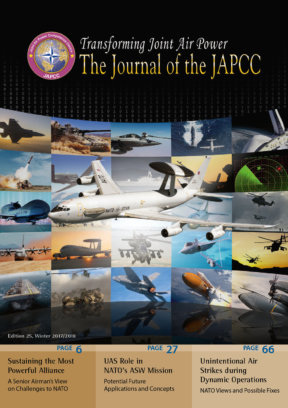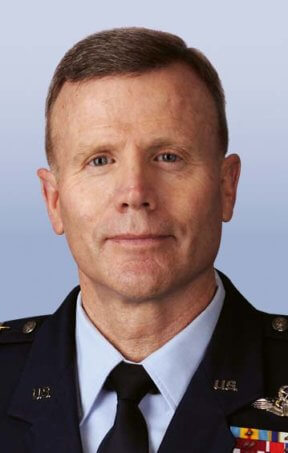Introduction
Over the past year and a half, it has been a privilege to command NATO’s Allied Air Command (AIRCOM), US Air Forces Europe and US Air Forces Africa. Add in the role as the Director of the Joint Air Power Competence Centre and it has been an honour to be part of four fantastic teams. As our Command Group has travelled throughout the NATO theatre, we have been continually impressed by the quality of the personnel that nations assign to NATO, the level of cooperation among our NATO Airmen, and with our joint and non-NATO partners. It is clear that our levels of cooperation have never been higher through the dedication to NATO’s three core tasks of Collective Defence, Crisis Management, and Cooperative Security, and precision focus on deterring potential threats to the Alliance. Having taken some time to reflect, there are some observations on the challenges facing our Alliance, and thoughts on the direction we are, or should be, heading.
NATO faces a 360-degree ring of security challenges. As receding polar ice opens up new trade routes and access to potential resources in the Arctic, the possibility for competition and friction between major seafaring nations grows. The Alliance is also facing challenges from near-peer competitors. To our east, Russia is posturing and exercising air, maritime and ground-based air defence forces along its western border with European nations, attempting to establish a sphere of regional control. Naval activity and exercises by potential adversaries have also increased in the Mediterranean, the Baltic Sea and the Atlantic Ocean. To the south-east, we face ongoing instability in the Middle East that fosters terrorist groups and generates a continuing flow of migrants and refugees into European and North American nations. To the south we also see a similar instability caused by radical ideologies, human rights abuses, and economic challenges, as well as competition for partners and resources. It is absolutely critical that our nations solidify the cohesion of our Alliance to overcome each of these challenges, counter any overt attacks, and deter future threats.
From Air Power towards an Integrated Joint Warfighting Capability
The key to deterrence is demonstrating that NATO has both the political will and the military capability to back up the assurances of the North Atlantic Treaty. Any potential adversary, whether near-peer, small state or non-state, must understand that hostile action towards any NATO nation, in any domain, will be met with the overwhelming might of 29 allied nations. A robust and credible air and space force that can establish an umbrella of air superiority over any land or maritime battlespace enables freedom of action for our land, maritime and special operations forces. Air Power is a cornerstone of effective deterrence. The soldiers and sailors in land and maritime battle groups who stand ready to counter incursions into NATO nations are the best in the world, but they must be protected and supported in the third dimension in order to succeed.
We are currently operating in a strategic environment where budgets and personnel resources have been reduced in almost every allied nation over a period of more than ten years. In parallel, we see threats to our collective security emerging, or in some cases re-emerging, from every point on the compass. In many nations, the pendulum has reversed course and defence budgets are now trending upwards. However, new investments take years to manifest into new capabilities. This means that we have to think harder about how to get the most out of the resources we have available now and those becoming available in the near future, such as fourth and fifth generation fighter integration. We must find innovative ways of posturing our forces that make them flexible, so we can ‘lift and shift’ them on short notice to face challenges from any direction, and from more than one direction at the same time. Additionally, we need to better integrate all of our warfighting and supporting domains: air, land, maritime, special operations, space and cyber, in order to comprehensively address all aspects of a given situation. One way we do that is through multi-domain command and control (MDC2), which goes beyond supported and supporting commands, to an integrated joint warfighting capability, and is one way in which our Alliance will stay ahead of the ever-increasing speed of warfare.
Networked Operations – Cyber and Space
Warfighting capabilities are evolving beyond the speed of voice communication and human decision-making through the use of networked communication and data-sharing at machine speeds. In order to leverage new systems fully, we must utilize computer and datalink capabilities that are heavily dependent on the space and cyber domains. While there is tremendous emphasis on developing cyber capabilities and strengthening cyber security, we must keep in mind that much of our capability in this domain, including our ability to command and control forces relies on space-based satellite systems. Space provides communication links, position, navigation and timing information for aircraft and ship movements and precision-guided munitions employment. Space also provides an Intelligence, Surveillance and Reconnaissance (ISR) capability as well as real-time global weather tracking. However, some of our space assets are still not as interconnected as we would prefer. Due to the expense involved in fielding space systems, the only way to exploit the domain effectively and maximize space support to NATO operations is to link national capabilities and consider approaching future acquisitions in a multilateral manner. Moving forward, we need to increase investment in space to preserve and protect the capabilities we already have, and to improve the ubiquitous situational awareness it provides. Robust space capabilities are critical to MDC2 and to most of our modern weapon systems, as well as to the Alliance cohesion that is essential to deterring many of the threats we face.
The Importance of Robust and Realistic Training and Exercises
The foundation of a robust and credible Alliance deterrence posture is a visible and realistic training and exercise program. In AIRCOM, the degree of cooperation in our NATO exercises continues to improve. Recent NATO and European exercises like Baltic Operations, Arctic Challenge, Saber Strike and Trident Javelin highlight the improvement. However, we still have challenges. With real-world operations ongoing and limited resources, it can be hard to pull together a comprehensive joint force for live training. To offset this, we need to continue to explore and expand virtual and constructive training capabilities to link up with our live forces. We also need to ensure we are challenging our warfighters with the most realistic scenarios they might face from a near-peer adversary. We have become complacent from a quarter-century of NATO being effectively unchallenged militarily, and some achievable conditions may not be as certain against emerging competitors. We need to challenge our Airmen, Soldiers, Sailors, Marines and their leaders from the tactical to the strategic levels with exercise scenarios which test them to their limits and see how they react and adapt – this is how we really learn and improve. In addition, we can no longer afford to begin exercises at a point that assumes air, space and cyber superiority have been successfully established; we must exercise the critical first days of the fight and do so jointly. This is important to building a cohesive and interoperable multinational force, and to demonstrating combined arms credibility in the eyes of would-be aggressors.
Fifth Generation System Integration
As we continue to improve joint exercises and training, we need to figure out how to better integrate fifth generation capabilities into not only our national forces, but into the NATO Force Structure (NFS) as well. The F-35 is a game-changing system that brings myriad advanced capabilities to the table giving us a degree of access in contested environments that we have never experienced before. We are already working on how we will make the F-35 interoperable across the joint services of participating nations, and also on how it will integrate into existing NATO force and command and control (C2) structures. Ultimately, we need to mature fifth generation Air C2 systems, including the next Air Surveillance and Control platform that replaces our Airborne Warning and Control System (AWACS) fleet, to get the maximum benefit from fifth generation combat systems as they become available. We are also working on how to maximize the flexibility and punching power of NATO F-35s through cooperative information, maintenance and logistics programs. Figuring out how to share the burden in these support areas will yield important lessons to speed the integration of various advanced systems when they come online. Other advanced fighter, tanker and transport aircraft are also going to be common to multiple nations, so developing doctrine and standardized agreements for support will speed their progress towards operational capability. These are critical first steps in the transformation of NATO Air and Space Power to a fifth generation force that sustains its position as the preeminent military force in the world, and in doing so continues to deter major conflicts not just on the European continent, but globally.
Leveraging Partnerships to Address Out-of-Area Challenges
Fortunately, NATO has many partners across the globe. These include European nations such as Sweden, Finland, and Austria, as well as others in key areas worldwide, including Australia, New Zealand, Japan, the Republic of Korea, Colombia, Mongolia, and others. These partnerships are critical to addressing ‘out of area’ challenges such as piracy off the Horn of Africa, ongoing rebuilding challenges in Afghanistan, and countering the Islamic State in Iraq and Syria (ISIS). Such challenges are not within the geographic confines of NATO, but their outcomes affect all of our long-term interests.
Africa is extremely important to NATO. Europe and Africa are historically and inextricably linked, sharing the Mediterranean Sea across which flow people and trade. Both continents also border and are affected by the flow of refugees and the export of hostile ideologies from the conflicts in the Middle East. As Commander US Air Forces Africa, I see the challenges facing African nations; these are significant challenges and are not Africa’s alone. Problems in sub-Saharan Africa affect human rights, access to resources, and feed instability to the north that flows across the Mediterranean into Southern Europe, from Morocco to Gibraltar and up into Spain, and from more central parts of Africa up to Libya and across to Italy. These mass migrations create internal humanitarian, economic and security challenges for Alliance nations so finding ways to stabilize Africa is vital. NATO has been assisting the African Union (AU) since 2005 with efforts to build their own peacekeeping forces and to restore and maintain stability in areas such as the Sudan, Somalia, Mali and the Central African Republic. NATO also took the lead role in Operation Unified Protector over Libya in 2011. Due to the vast distances involved in Africa, Air Power is a realistic solution for transporting AU peacekeeping forces and supplies to troubled areas, particularly those in the interior of the continent. Both the NATO Heavy Airlift Wing and the national air forces of several NATO allies have supported and continue to support these operations, and the Alliance has opened seats in the NATO School at Oberammergau to AU members to help build their own capabilities.
Conclusion
The stability of the NATO Alliance is immeasurably important to the maintenance of peace and order in the world, not just the North Atlantic. The challenges we face are multi-directional and multi-dimensional, and they will not be overcome without multilateral and multi-domain solutions. We are incredibly proud of the men and women of NATO who are performing missions at home and abroad, conquering these challenges every day. We are proud of the way they are all supporting their counterparts in the other components, despite the manning and resource obstacles we all face. From the tactical level to the strategic, they are ‘out-thinking’ and ‘out-working’ our adversaries to sustain the most powerful military alliance ever created and to deter those who would do us harm. It is an honour to continue serving alongside these heroes!












